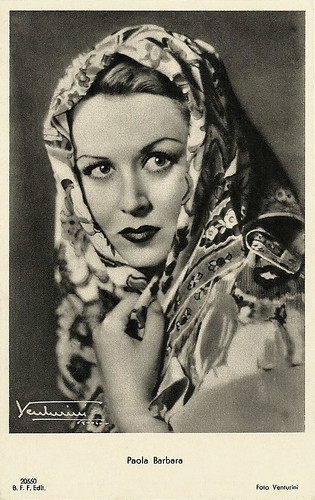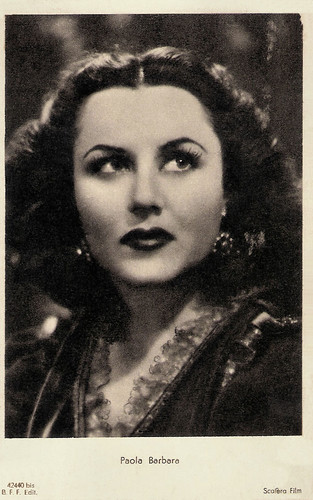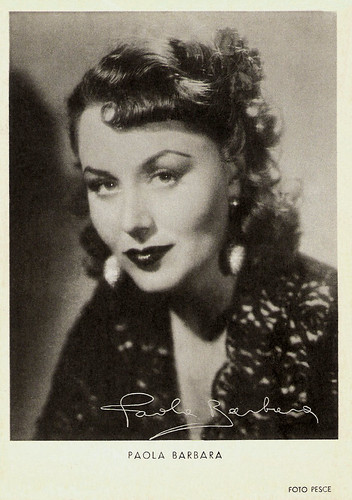
Italian postcard by Ballerini & Fratini, Florence, no. 20680. Photo: Venturini.

Italian postcard by B.F.F. Edit. (Ballerini & Fratini, Firenze), no. 42440 bis. Photo: Scalera Film.
Jealous courtesan
Paola Barbara was born Paola Proto in Rome, in 1912. From the late 1930s to the late 1940s she was one the most popular and prolific actresses in Italy. Barbara’s career started with a small part in Campo di maggio/100 Days of Napoleon (Giovacchino Forzano, 1935) and quickly she became successful.
In the comedy Ammazzoni bianche/White Amazons (Gennaro Righelli, 1936), Barbara had the lead, opposite Sandro Ruffini and Doris Duranti. In the mid-1930s she was active at the Pisorno studios at Tirrenia, near Livorno.
From the late 1930s on she mainly worked in Rome, e.g. at the Scalera studios. Barbara acted in many comedies by Guido Brignone, Mario Mattoli, Amleto Palermi, and Giacomo Gentilomo, but also in dramas by Marco Elter and Raffaele Matarazzo. In the adventure and spy story Lotte nell’ombra/Battles in the Shadow (Domenico Gambino, 1939), she co-starred with Antonio Centa and Silvana Jacchino.
In Il ponte dei sospiri/The bridge of sighs (Mario Bonnard, 1940), a remake of a period piece set in Venice, Barbara was the courtesan Imperiale, who out of jealousy falsely accuses her ex-lover Rolando Candiano (Otello Toso) of having murdered her husband.
Already in 1921, there had been a silent version of Il ponte dei sospiri/The Bridge of Sighs (Domenico Gaido, 1924), with Luciano Albertini as Rolando and Antonietta Calderari as his jealous and vengeful ex. In the late 1930s, Barbara also founded her own stage company, Gizzi-Barbara-Annicelli.

Italian postcard by ASER (A. Scaramaglia Edizioni Roma). Photo: Ghergo.

Italian postcard by Rizzoli & C., Milano, 1936-XV.
A first, modest step towards Italian neorealism
Paola Barbara’s best and most acclaimed part was the lead in Amleto Palermi’s film La peccatrice/The Sinner (1940). It tells the story of a naive provincial town girl whose hypocritical lover (Gino Cervi) has promised to marry her but he dumps her when she is pregnant.
Out of shame she runs away from home, loses her child, and becomes the nanny to a farmer’s family in another provincial town. There a new lover (Vittorio De Sica) treats her meanly when he knows of her past, so she runs away again.
Moved to the city, she is forced to become a prostitute. The death of another prostitute from the same brothel makes her realise the low depths of her life, so she returns to her mother in the countryside. There she meets the man who started all her misery, menaces him with a knife and expresses all her bitterness. Relieved, she leaves the inn.
La peccatrice was already shot in 1938 but only released in Italy in September 1940, after being shown at the Venice film festival. Afterwards, it has been interpreted as a first, modest step towards Italian neorealism.
The film was shot at the Centro Sperimentale di Cinematografia, the Roman film academy, with sets by Antonio Valente, who taught scenography at the academy (1936-1968) and had also been the architect of the new building (opened 1940).

Italian postcard by Rizzoli & C., Milano, 1938. Photo: Montebone.

Italian postcard by Rizzoli & C., Milano, 1941. Photo: Venturini.
In Madrid
Paola Barbara married director Primo Zeglio, who directed her in nine films. In 1943 they fled to Spain because of the war in Italy and stayed there until c. 1947. In Madrid, Zeglio first directed Barbara in Febbre/Fever (1943), and Accadde a Damasco/It Happened in Dasmascus (1943).
Later Barbara also acted in various films by Spanish directors, such as Luis Marquina, Carlos Arevalos, Juan de Orduna, Rafael Gil, and Florian Rey. During their stay in Madrid, Barbara had the possibility to work on dubbing American films by 20th Century Fox, destined for the Italian market once the war would be over. She collaborated on the dubbing with Italian actors who were in Spain as well to act in Italo-Spanish productions, such as Emilio Cigoli, Anita Farra, Felice Romano, Nerio Bernardi, and Franco Coop.
Films she helped dub were How Green Was My Valley, Charley’s Aunt, Suspect, The Sign of Zorro and The Shadow of a Doubt. Until 1949 Barbara alternated acting in Italy with films shot in Spain. Zeglio continued to direct her in several Italian productions, such as the epic Nerone e Messalina/Nero and the Burning of Rome (1953), in which she played Nero’s mother Agrippina opposite Gino Cervi as Nero and Yvonne Sanson as Messalina.
While her parts were still substantial in the 1950s, slowly they became less prominent in the 1960s. This was even so in the films by her husband, such as the Western I quattri inesorabili/The Relentless Four (1965), starring Adam West. She returned to the stage in the 1950s with her company Barbara-Tamberlani-Villa, and was successful in plays such as '...poi venne l'alba' (then came the Dawn...) (1956) and 'Processo di secondo instanza' (1967).
The last film parts of Barbara were e.g. in Sidney Lumet’s psychological drama The Appointment (1969) starring Omar Sharif, the Western A Man Called Sledge (Vic Morrow, 1971) starring James Garner, and Irene, Irene (Peter Del Monte, 1975), starring Alain Cuny. Paola Barbara died in Anguillara Sabazia, in 1989. She was 77.

Spanish collectors card by I.G. Viladot, Barcelona. Photo: Cifesa.

Italian postcard by Casa Editrice Albora, Milano, no. 1950. Photo: Pesce.

Italian postcard by Stab. Angeli, Terni. no. 70. Esclusiva di Ditta Terzoli, Roma. Photo: Gneme.
Sources: Wikipedia (Italian, German and English), and IMDb.
This post was last updated on 3 May 2023.
No comments:
Post a Comment